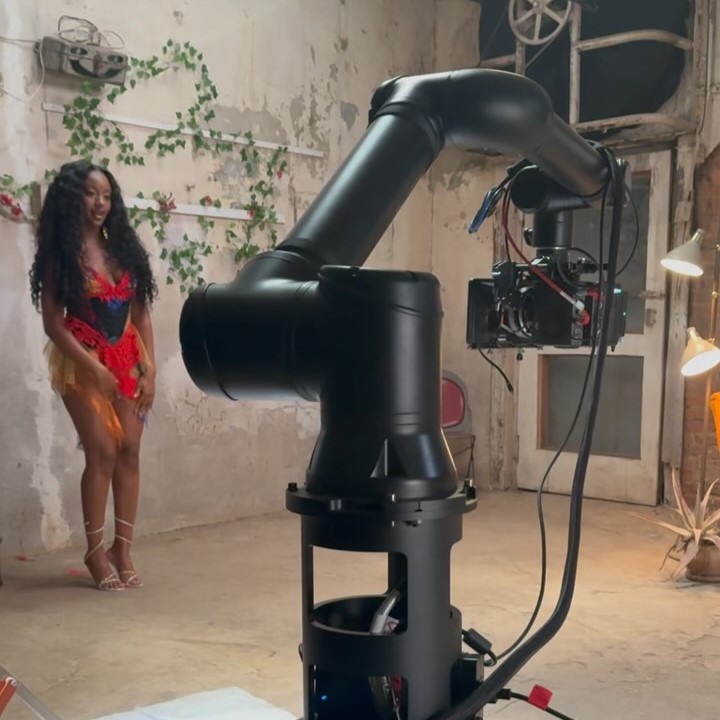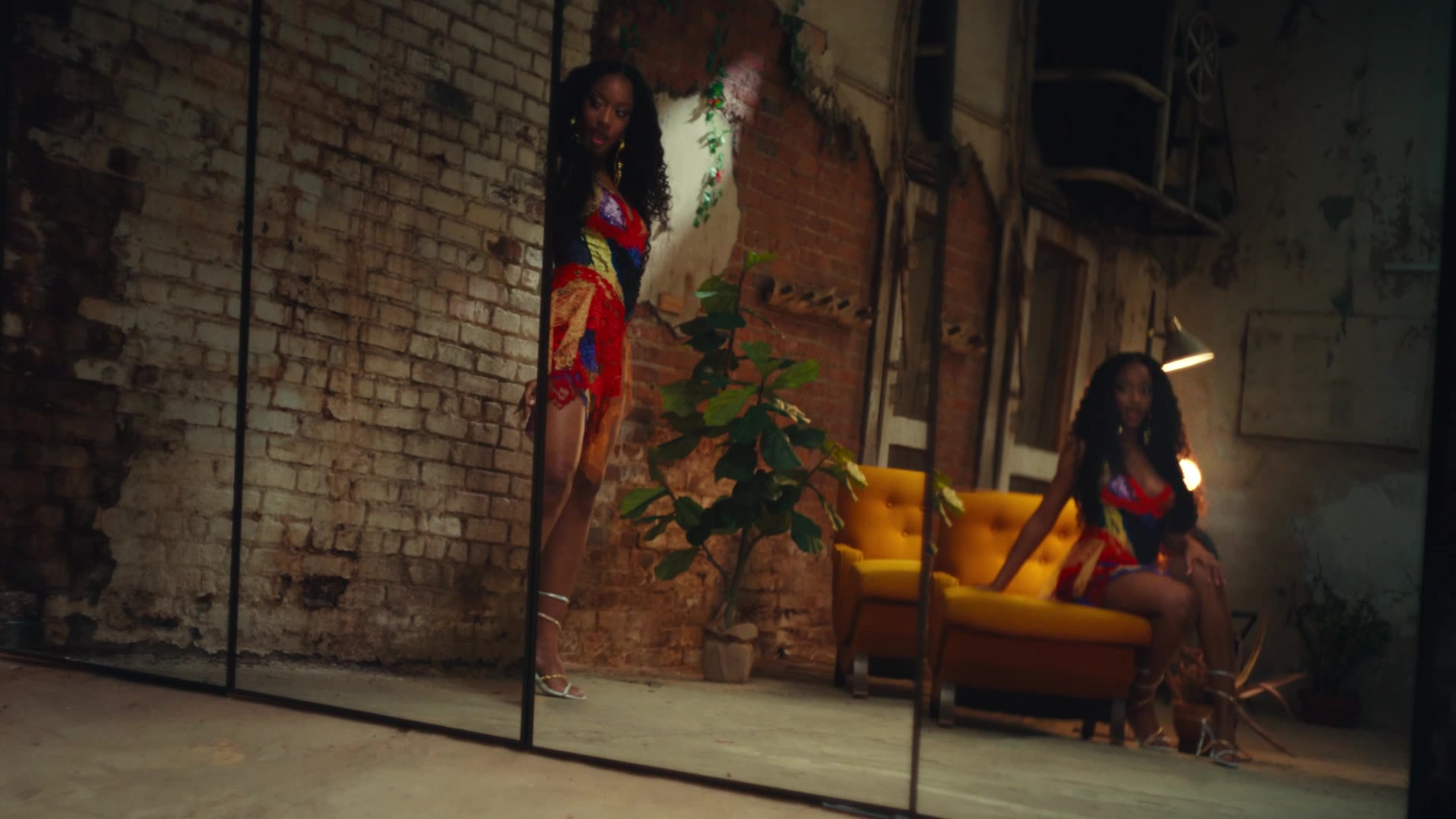Putting the 'Control' in Motion Control
CASE STUDY
For the release of Ayra Starr’s new album, Strange Nature enlisted Joel Nunez of Glammy to execute the music video for Control. Shot in a single day at a tight, multi-floor location in New York City, the team used the Cinebot Mini to create flawlessly synchronised, multi-pass shots, featuring Ayra performing in several locations within the same frame.
For the release of Ayra Starr’s new album, Strange Nature enlisted Joel Nunez of Glammy to execute the music video for Control. Shot in a single day at a tight, multi-floor location in New York City, the team used the Cinebot Mini to create flawlessly synchronised, multi-pass shots, featuring Ayra performing in several locations within the same frame.
PROJECT OVERVIEW
For the release of Ayra Starr’s new album, production company Strange Nature was tasked with delivering three visually distinct music videos—all shot in a single day. Each project had its own creative identity, but Control stood out as the most technically ambitious. DP Anni Versity had a vision for the concept: a one-take-style execution, with multiple cloned performances of Ayra layered together within the same frame. As the camera moved through the space, Ayra would appear in several different locations—including one shot where two versions of her appear inside a mirror together. To make it work, the camera needed to move with repeatable precision, frame-accurate timing, and a natural, flowing feel to it.
Bringing this idea to life would require dynamic motion control — and fast. Executive producer for Strange Nature, Bryan Schmier brought in owner/operator of Glammy Inc. — Joel Nunez and his Cinebot Mini , alongside freelance operator Josh Treadaway to execute this shoot. With limited prep time and a visionary director who had worked closely with Ayra to shape the creative, but hadn’t worked with a motion control rig before, this was no old-school moco job. Still, with the right crew and the right kit, Joel and the team pulled off something special.

We’re working with more filmmakers now, not just motion control experts, thanks to the new Cinebot Minis and Maxes. They’re so accessible and easy to bring on set quickly. It’s all about aesthetics, and filmmakers can now use a robot to enhance that—like performing a repeat pass to create a natural, cool look that makes people ask, ‘You can’t do that with a Steadicam—how did they do that?’ without it being obvious it’s a robot.
Strange Nature
THE CHALLENGE
Time was tight. The team had just one location—a multi-floor townhouse in New York City that wasn’t built for production, with narrow, winding staircases, tight rooms, and limited power. On top of that, they had a single day to shoot all three videos, each with its own approach: one built around heavy Steadicam work, one featuring a massive jib setup, and ‘Control’, which would be entirely shot with the Cinebot Mini. While each crew was setting up, the others were already rolling, meaning there was zero downtime and no room for error.
There was also the matter of the custom camera rig the crew had built. The camera package—a fully built-out Alexa Mini LF—came in just under 10kg, maximising the use of the Cinebot Mini’s payload. At the same time, the team needed to increase the speed of certain moves to accommodate high-frame-rate shooting. All of this had to be achieved without any hiccups, in a way that preserved the fluid, natural movement the director was after. And because Control relied on multiple passes synced to timecode, everything needed to align—visually and rhythmically—down to the frame.

This shoot was definitely the ideal shoot for the Cinebot Mini. Four flights of narrow, winding stairs in an NYC townhouse, just using 110v house power. Try doing that with anything else!
Glammy Inc.
The Solution
This was exactly the kind of shoot the Cinebot Mini was built for. Its compact footprint meant it could slot into tight corners and glide through narrow rooms, yet it still had the strength and precision to handle a nearly maxed-out camera rig. It ran off house power without needing its own generator or heavy power distro—saving time, space, and complexity on set. When it came to repeat passes, it delivered pixel-perfect consistency every time, allowing for seamless layering of Ayra’s performances, all perfectly synced to the beat.
What made the whole thing work was a smart blend of ‘on-the-fly’ pre-production and on-the-day flexibility. While the other two videos were being shot, Josh used Simul8 to build and tweak shots ahead of time, giving the director a clear look at what was possible before even stepping onto that section of the set. The result was a smooth transition between planning and execution—Josh could show DP Anni Versity options, adjust moves on the fly, and keep the momentum going even while other setups were underway.
Programming was done exclusively in Flair 7, which made a noticeable difference. Its new interface is clean and user-friendly, removing the intimidating look of older motion control software. With the 3D rig view always visible, Josh could see the full environment while dialling in the moves. He leaned into Flair’s curve reversal tool to create soft, floaty motion—replacing the hard keyframes often associated with high-speed robot moves. It gave the footage a flowing, steadicam-like quality while still maintaining the high level of precision motion control is known for.
The Cinebot Mini was a game-changer for us. It let us move from one shot to the next without losing any momentum or time. It really opened up the space for collaboration, helping us bring the director’s vision to life in ways that would’ve been more difficult a short while back.
Josh Treadaway Moco
The Cinebot Mini made it possible to execute shots that would’ve been either impossible or far more time-consuming on a traditional motion control system. Joel, leveraged the Mini’s arm configuration to stay in top mount while pulling off shots that would usually require side mount on other systems. This helped alleviate typical troubleshooting issues, saved significant time and kept the production flowing smoothly.
Visually, the result didn’t scream “robot.” And that was the point. This wasn’t a showcase of high-speed, hyper-stylised motion control. The goal was to move subtly, beautifully, and then wow the audience when Ayra appears multiple times in the same frame, perfectly aligned and perfectly in sync. It’s the kind of thing that makes you look twice and ask, “Wait—how did they do that?”
Thanks to the Cinebot Mini, the team could push the boundaries of this shoot both creatively and practically. It fit the location, matched the speed of the production, and, most importantly, nailed the project brief with no stone left unturned, to produce a truly outstanding music video.
CREDITS
PRODUCTION COMPANIES:
Taomak Films
Strange Nature
DIRECTOR:
Annie Bercy
CREATIVE DIRECTORS:
Scry Town
EXECUTIVE PRODUCERS:
Musically
Bryan Schmier
DIRECTOR OF PHOTOGRAPHY (DP):
Leo Scherman
PRODUCTION MANAGER:
Ross Ginsberg
1st ASSISTANT DIRECTOR (1st AD):
Onur Can
2nd ASSISTANT DIRECTOR (2nd AD):
Belen Vilarrasa
TRUCK PRODUCTION ASSISTANT (Truck PA):
B Cinematics
PRODUCTION ASSISTANTS (PAs):
Micultra
Jay Mieleger
Heroki Hlr
1st ASSISTANT CAMERA (1st AC):
Sharpy Sharp
STEADICAM OPERATOR:
Malcolm Tom
CINEBOT OPERATORS:
Joel Nunez
Josh Treadaway
JIB OPERATOR:
Lost Making Good Time
GAFFER:
Adam J. Reichardt
KEY GRIP:
Lilly Alban
BEST BOY ELECTRIC (BBE):
Lauren Guiteras
BEST BOY GRIP (BBG):
Surplus Kulture
PRODUCTION DESIGNER:
B. Her Studio
SET DECORATOR:
JD Moran
SET DRESSER:
Carly Capote
FLORIST:
Kimberly Yetka-Rosario
ART ASSISTANTS:
Valeria Flores
Kaelander
EDITORS:
Annie Bercy
Brayden Ahn
VISUAL EFFECTS (VFX):
Skinny Davinci
OCD VFX
